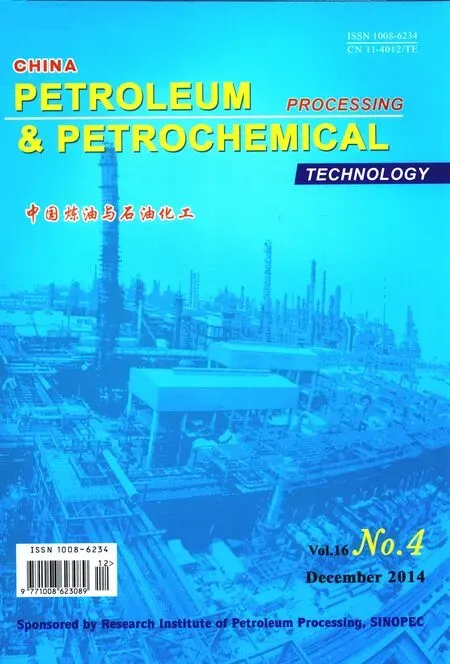A Sintering-resistant Pd/C Composite Catalyst for Ethylbenzene Dehydrogenation Developed by CAS Institute of Metals
Carbon deposition is a commonplace phenomenon occurring in the catalytic reaction process, in particular in the system of direct dehydrogenation of ethylbenzene, because the reactant — ethylbenzene molecules on the surface of metal oxide catalysts are prone to quickly form carbon deposits, leading to deactivation of catalysts. Recently, the associate research fellow Mr. Liu Hongyang and the research fellow Mr. Su Dangsheng of the State Shenyang Material Science (United ) Laboratory of the Institute of Metal Research, CAS by taking advantage of the carbon deposition process during direct dehydrogenation of ethylbenzene have ingeniously designed a Pd/C composite catalyst. This catalyst in comparison with the traditional commercial carbon nanotube supported Pd catalyst shows a significantly improved performance in terms of its catalytic activity and sinteringresistant ability.
Palladium as an important metal catalyst plays a key role in the catalytic hydrogenation reaction, the coupling reaction and the reaction for removal of toxic gases. In order to inhibit the aggregation of palladium nanoparticles in the course of application, the Pd nanoparticles are generally supported on specific carrier. A lot of studies have revealed that the carbon material is an important support
A Sintering-resistant Pd/C Composite Catalyst for Ethylbenzene Dehydrogenation Developed by CAS Institute of Metals
Carbon deposition is a commonplace phenomenon occurring in the catalytic reaction process, in particular in the system of direct dehydrogenation of ethylbenzene, because the reactant — ethylbenzene molecules on the surface of metal oxide catalysts are prone to quickly form carbon deposits, leading to deactivation of catalysts. Recently, the associate research fellow Mr. Liu Hongyang and the research fellow Mr. Su Dangsheng of the State Shenyang Material Science (United ) Laboratory of the Institute of Metal Research, CAS by taking advantage of the carbon deposition process during direct dehydrogenation of ethylbenzene have ingeniously designed a Pd/C composite catalyst. This catalyst in comparison with the traditional commercial carbon nanotube supported Pd catalyst shows a significantly improved performance in terms of its catalytic activity and sinteringresistant ability.
Palladium as an important metal catalyst plays a key role in the catalytic hydrogenation reaction, the coupling reaction and the reaction for removal of toxic gases. In order to inhibit the aggregation of palladium nanoparticles in the course of application, the Pd nanoparticles are generally supported on specific carrier. A lot of studies have revealed that the carbon material is an important support
for the Pd catalyst. However, the traditional Pd/C catalyst in the course of reaction is susceptible of either loss of palladium nanoparticles or increase in particle size after agglomeration because of the weak interaction between the carrier and the Pd nanoparticles.
The research team by taking advantage of the carbon deposits formed in the course of reaction has prepared a Pd/C composite catalyst with special structure. The electron microscopic study has shown that in this catalyst the palladium nanoparticles on the active sites are partly imbedded in the carbon carrier to apparently enhance the interaction between the palladium nanoparticles and the carrier, resulting in an increased stability of the Pd/C catalyst. The experimental results have shown that after being treated by argon stream at 500 ℃ the Pd/C composite catalyst did not experience either the migration or the growth of palladium nanoparticles, whereas the traditional Pd/CNT catalyst would undergo severe sintering under the same treating conditions. In the meantime, during the liquid-phase carbon-carbon coupling reaction this Pd/C composite catalyst also demonstrate excellent performance of repeated use to display a great potential to replace the existing commercial catalysts and show broad commercial application prospects.
- 中国炼油与石油化工的其它文章
- Comparative Studies on Low Noise Greases Operating under High Temperature Oxidation Conditions
- A Method for Crude Oil Selection and Blending Optimization Based on Improved Cuckoo Search Algorithm
- Experimental Research on Pore Structure and Gas Adsorption Characteristic of Deformed Coal
- Mathematical Model of Natural Gas Desulfurization Based on Membrane Absorption
- Ni2P-MoS2/γ-Al2O3Catalyst for Deep Hydrodesulfurization via the Hydrogenation Reaction Pathway
- Effects of Airflow Field on Droplets Diameter inside the Corrugated Packing of a Rotating Packed Bed

